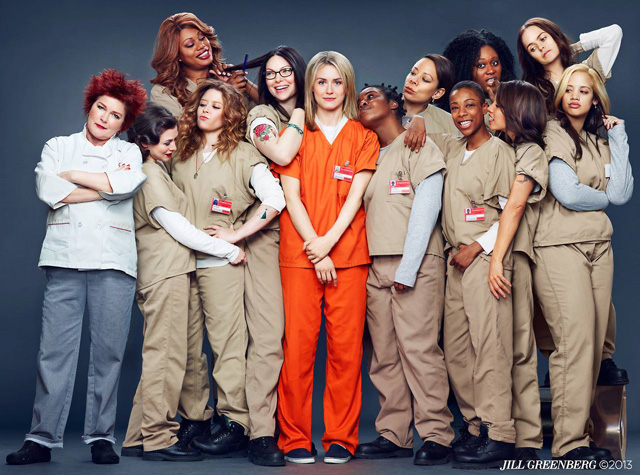Television: What I Loved (and Didn’t) in 2013
 Monday, December 23, 2013 at 3:28 PM by
Monday, December 23, 2013 at 3:28 PM by  Nick DeMartino
Nick DeMartino Yes, we’re still in television’s Golden Age (or its second, maybe third). And yes, there is now a healthy battle amongst the chattering classes over each medium’s preeminence: TV is better. No, Cinema is better.
This is a mug’s game if there ever was one, to my mind, akin to suggesting that novels are intrinsically better than poems, or short stories, or biographies. What is unarguable (if anything can be these days) is the artistry and sheer craft of the work that comes into our homes via television -- it optimizes the inherent intimacy and complexity of the serial story forms emergent in the last decade and compels us to become attached to a story world, a set of characters, a storytelling style, so much so that we come back, week after week, year after year.
Or we did until the emergence of binge watching, enabled first by TV on DVD, and especially since the advent of streaming. Now binge-watching is a thing of its own, almost a format thanks to Netflix’s release pattern. Made-to-binge series are almost like 13-hour movies, with very little repetitive exposition required, and less reliant upon the predictable beats and conventions of old-school TV formats.
Certainly cable adheres to a type of continuous story-stream formatting which is quite different from conventional network series, even the best of them. Longer story arcs, interesting character digressions, depth in texture and character. This is why TV is to be loved these days. And why picking just ten to be “best” is a mug’s game. And why there’s now a reason for this list – if you find a gem you haven’t seen and you trust me, just Google it. Chances are, it’s waiting for you to binge.
Breaking Bad was so great on so many levels, there’s really very little I can add. I was in the camp that liked it so-so in the beginning, went away in season 2, but came back to stay for the ride. This finale half-season seemed to do the impossible: sustain and intensify audience obsession for a long period of time and with a growing audience. Binge watching let laggards catch up so they could find out what all the fuss was about. What it was about was brilliant writing, acting and storytelling: a modern mythology with a flawed hero.
 The Cast of DR's BORGEN.Borgen is the best political drama on television, delivering pleasure in greater measure because of the unfamiliar setting, e.g., contemporary Danish parliamentary politics. Untethered from parties and histories known to me, this great drama of ideas and personalities became vivid and suspenseful on its own merits. Denmark has managed to adapt the HBO-style of serial storytelling into its own world in a unique and superb way. Let’s just hope Netflix or HBO don’t ruin it with a lame adaptation that sucks its cultural frisson out along with the unfamiliar language.
The Cast of DR's BORGEN.Borgen is the best political drama on television, delivering pleasure in greater measure because of the unfamiliar setting, e.g., contemporary Danish parliamentary politics. Untethered from parties and histories known to me, this great drama of ideas and personalities became vivid and suspenseful on its own merits. Denmark has managed to adapt the HBO-style of serial storytelling into its own world in a unique and superb way. Let’s just hope Netflix or HBO don’t ruin it with a lame adaptation that sucks its cultural frisson out along with the unfamiliar language.
Girls is criticized because its focus is privileged white girls in New York City, as if any milieu should be off limits no matter how great it is. And yes, Girls is great. Fearless, transgressive, confused and fucked-up, just like its ensemble of characters. These are people finding their way into adult life. Think back. It’s a messy time, not very graceful. I feel like Lena Dunham is a reporter from Mars, bringing back reports of the natives. I don’t live there, but I’m very curious.
Louie feels like a more grown-up version of Girls, only the dysfunctional anti-hero has lived decades longer, so it’s sadder still. While being funny. Because the lead character is a stand-up comedian, you could be lulled into thinking this is a form of reality TV. Not. It’s a carefully, courageously crafted deconstruction of comedy, with a lot of heart thrown in.
 ORANGE IS THE NEW BLACKOrange is the New Black is the new “it” show for me, dramatically better than “Weeds,” the previous series by Jenji Cohen. Both shows feature strong female leads in edgy situations, but “Orange” feels authentic, where I always felt “Weeds” to be contrived, however much I love Mary Louise Parker. “Orange” introduces an ensemble of largely unknown actresses portraying women like that you never get to meet. Funny, tragic, angry, outrageous, sexy, and full of heart, “Orange” is one for the books.
ORANGE IS THE NEW BLACKOrange is the New Black is the new “it” show for me, dramatically better than “Weeds,” the previous series by Jenji Cohen. Both shows feature strong female leads in edgy situations, but “Orange” feels authentic, where I always felt “Weeds” to be contrived, however much I love Mary Louise Parker. “Orange” introduces an ensemble of largely unknown actresses portraying women like that you never get to meet. Funny, tragic, angry, outrageous, sexy, and full of heart, “Orange” is one for the books.
The Americans is another great FX drama, set in Reagan-era Washington, D.C. in what turned out to be the finale stages of the Cold War. Our protagonists are Russian spies passing for a suburban family, with Margot Martindale as their controller. It’s a believable espionage suspense yarn bolted onto a family drama, and it works.
Justified stayed strong with Season 4’s quest for long-gone cocaine kingpin Drew Thompson, a plot driver which intertwines nicely with Raylan’s own crazy family story (not to mention the Detroit and Dixie Mafia, a tent revival scammer) and features a great ‘hiding-in-plain-sight’ denouement. The characters are fixed in place somewhat predictably, but tonally it’s spot-on.
Behind the Candelabra is something of a ringer on this list – for Soderbergh’s motion picture was delivered by HBO only when every single studio passed on this demented love story between Liberace and much younger lad, Scott Thorsen. Frank, telling and over-the-top, the picture is dominated by its superstar leads, Michael Douglas and especially Matt Damon.
Mad Men – I’m obsessed and cannot imagine a list of my favorite shows without MM, even if Season Six was all over the place. Nowhere on prime time do we get the sheer surrealism of Don Draper’s journey. We need to know where it ends. We must take this ride... along with so many great secondary characters. Roger had a particularly good year.
The Story of Film: An Odyssey – Mark Cousins is a better film historian and writer than he is narrator (for sure) and director, but I got used to his quirks, mainly because the information and THE CLIPS are remarkable. I learned so much, especially about national cinema of foreign countries. Even countries I’ve spent time viewing like France, Japan, and Italy, he uncovers some gems. And his work on the cinema of emerging nations is truly groundbreaking. That said, he’s difficult to binge watch, which I did in several batches. He’s so talky, he has to clutter the visuals with what look like travelogue footage. Everything he describes requires a superlative. And, for somebody who claims that real innovation never comes from Hollywood, he sure spends a lot of time telling us about Hollywood movies. But you will not find a film survey class this good anywhere.
The Fall is a BBC police procedural set in Northern Ireland starring Gillian Anderson, whose tough-as-nails Scotland Yard investigator picks up where Helen Mirren’s Jane Tennison stops. Mess with her at your peril, men.
The Following is the only network show I really couldn’t get enough of, which may say more about me than the networks, give that the protagonists are a Edgar Allan Poe cult leader and the FBI cop who pursues him. I liked the weird dramatic plot twists caused by the cult leader’s followers, and of course, James Purfoy, who does evil very seductively.
Masters of Sex tells the story of pioneering medical researchers Masters and Johnson, who were the first to study human sexual response back in the 60's. The setting shares some of the appeal of Mad Men, but with a lot more skin. (Why exactly is Showtime still squeamish about full male nudity, I wonder?) What keeps you coming back are the actors – I especially liked Lizzie Caplan – who create characters whose personal and professional lives get very, very messy amidst the space shots and political incidents.
Dancing on the Edge is a BBC mini-series shown in the US on Starz featuring Oscar contender Chiwetel Ejiofor as the leader of an all-black jazz band in 1930’s London. Told in flashback, the story shows how the band was able to overcome the limits of race through clever alliances with the upper class. As you might guess, it doesn’t end well.
Rectify is the first original series by Sundance, created by Ray McKinnon who played a subsidiary role in FX’s Sons of Anarchy. Aden Young is an ex-con, released from prison into small-town Georgia, after being exonerated for the murder of his girlfriend because of DNA evidence. Young captures the volatile mix of social fragility and bottled-up fury as he navigates the complexities of the life he had stolen from him. Plus, there’s a mystery at the heart of the set-up: if he didn’t do it, who did?
Among the other series I quite enjoyed this year were: Top of the Lake, Sons of Anarchy, Bates Motel, The Newsroom, The Bridge, Veep, Downton Abbey, Game of Thrones, Treme, Boardwalk Empire, Ray Donovan, Hit & Miss, Silk, The Paradise, Orphan Black, Luther, Broadchurch, Arrested Development and Modern Family.
I watched, but was disappointed in: Homeland (preposterous), Sherlock (pandering), House of Cards (a Democrat from South Carolina in a political drama?), Spies of Warsaw (some things aren’t meant to be adapted), Banshee (great premise, hot cast, gratuitous sex and violence), Defiance (yikes), Low Winter Sun (yawn), Nurse Jackie (faded), Enlightened (annoying), American Horror Story: Coven (craven).
The rest: well, I didn’t watch, did I?







